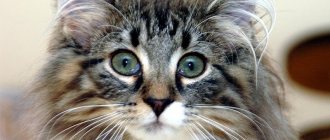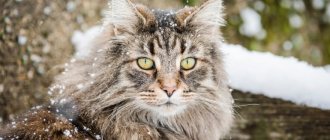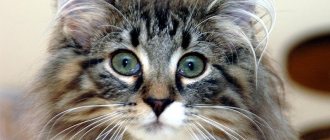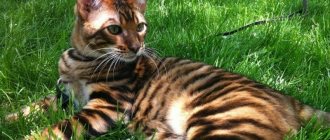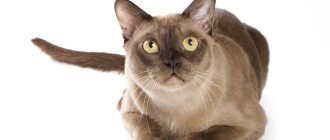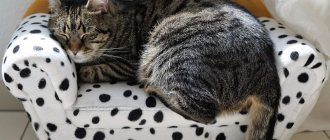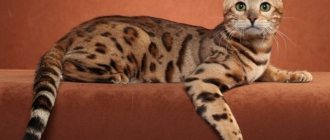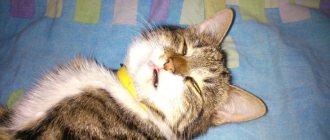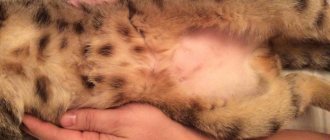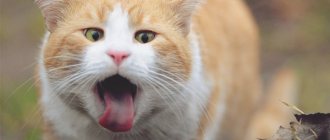Origin story
The history of Sokoke began in the Sokoke region of Kenya.
Local resident Jenny Slater, while processing a coconut plantation, found an unusual type of kitten there. The kids were absolutely wild, but so beautiful in appearance that she took a couple with her. The kittens took root in her house, created a pair, and gave birth to kittens. Through word of mouth, the kids began to be adopted as a new breed of Sokoke: several went to Italy, others to Denmark.
A few years later, curious people explored the breed. It turned out that the DNA of these cats is similar to the DNA of the cats of the distant island of Lamu, as well as the street cats of Eastern Kenya. It was decided to inject fresh blood into the breed, and in 2008 it was officially recognized by the International Cat Association.
There is one Sokoke nursery in Russia - in Moscow. Cats are also raised in Ukraine. A baby not for breeding and without documents costs about 30,000 thousand rubles. A show-class specimen costs much more: up to 100,000 rubles.
Diseases of Sokoke cats
As mentioned earlier, due to their active life, their nervous system is slightly shaken, and the cats themselves are very vulnerable. According to some observations, cats may experience seizures. Most often this happens during the mating season.
This nuance is also a genetic disease. They may become overexcited - the cat will run and jump around the room, not listening to anyone. Sometimes the reason for this behavior does not lie in heredity.
The cat may have worms, ear pain, or may have contracted the plague somewhere. If the Sokoke starts to behave this way, then you should not hesitate - you should immediately contact a veterinarian.
Vitamin E and taurine can satisfy the cat's need for vitamins. You need to give her food containing these substances regularly. They help strengthen the nervous system and promote good metabolism.
Standards
| Standard | Description |
| Head | Wedge-shaped, small in size. The muzzle is slightly elongated, the chin is wide, the forehead is flat, the cheekbones are clearly visible. The nose is small, neat, with a bend at the bridge of the nose. The whisker pads are round and small. |
| Ears | Medium in size, often with tassels at the tips, rounded. |
| Eyes | Large, almond-shaped, expressive, always outlined in black. Iris color: from light amber to green. |
| Torso | Graceful, round, with a broad chest and well-developed muscles. |
| Limbs | Long, slender, front ones shorter than rear ones. The paws are small, but wide and flattened. |
| Tail | Long, dense, slightly tapering towards the end. |
| Wool | Fits tightly to the skin, hard, without undercoat. |
Other names of the breed: Kenyan forest cat, soukok, hanzonzo.
General impression: strong, large cats with graceful movements. Males are half the size of females.
Maintenance and care
These exotic cats are very easy to care for, and they will not cause any trouble to the owner.
- The short hair of animals does not need frequent combing; it is enough to brush their thick coat once every one or two weeks.
- The Soukok cat loves to swim and can even jump into the bath herself to take water treatments.
- Ears and eyes are also easy to care for. Once every few days they are cleaned with a cotton swab or a cloth soaked in warm water.
- The Sokoke cat breed is distinguished by its mobility and energy, so the exotic pet will only be grateful to its owner if he takes it for a walk.
But do not forget that these animals are accustomed to the hot African climate. It is not recommended to walk them in winter, otherwise the pet may catch a cold.
Colors
Sokoke can have different shades of tabby color, both warm and cool, but a must have is a ticked coat and a black tip of the tail. There is always an elegant “necklace” (solid or with breaks) on the neck, the letter “M” on the forehead, a “bull’s eye” on the side, and a “butterfly” on the back.
In the photo there are cats of the Sokoke breed of popular colors
The cost of a Sokoke kitten is high. There is only one nursery in Russia, so the price for an individual starts from 40,000 rubles. Please note: this is the cost of a pet class kitten, i.e. exclusively for domestic keeping and often with some kind of “defect” in appearance or physical defect. If you want to buy an animal for breeding and participation in competitions, you will have to travel for it: the nearest nurseries selling show-class kittens are only in Europe. Accordingly, the price will be high.
Character traits
Beneath the wild appearance of Kenyan beauties lies an extremely friendly and affectionate nature. Sokoke cats are very sociable and inquisitive pets; they quickly get used to their owner and will follow on his heels.
Sokoke kittens are tireless, curious creatures that take an active interest in every corner of the house. Adorable little ones can spend days exploring their surroundings, surprising their owners with their playfulness and insatiable thirst for adventure. Nothing will escape the attention of a playful little kitten, because he just needs to check what is on the top shelf of the closet, in the owner's cosmetic bag or in the kitchen cabinet.
Kenyan beauties do not have such a character trait as aggressiveness at all. Therefore, they get along well with other pets.
But their friendliness does not extend to small pets, so the hamster’s cage or aquarium should be kept tightly closed and preferably out of their reach.
Character and behavior
Sokoke is a real little sun, mischievous and playful. At dawn, the cat will come running to your bed and will persistently “tell” you about the beauty of the new morning, and during the day it will not let you get bored, inviting you to play and have fun with it. They get along well both in an apartment and in a private house, but remember that the genetic memory of the Sokoke will require freedom and space. Therefore, you will have to often take your cat for walks, set up a play corner at home, and generally devote a lot of time to your pet.
Toys will help, but for a while: Sokoke needs communication with its owner. Bored, he will try to come up with entertainment for himself: it could be wild jumps on shelves, jumping from cabinet to cabinet, climbing curtains, hunting for sunbeams, and so on. And if something fell from somewhere and broke, it’s not his problem, sorry.
It is better to walk Sokoke not on asphalt streets, but in a forest or park. Give your cat the opportunity to climb trees, chase birds through the bushes, wet his paws in puddles - and he will be very happy!
Sokoke quickly become friends with other animals. They are not afraid of cats, or even large dogs, and immediately let others know that they will be able to stand up for themselves in the event of a conflict. But they will be the first to show aggression only in case of obvious danger.
Name the cat who always wanted to live together
BasilioLeopold
They love small children very much and perceive them as their wards who need constant supervision and care. Affectionate and gentle with loved ones, they treat strangers with feigned indifference, but in their souls they die of curiosity to study a new person more closely.
They quickly adapt to a new place and are not afraid of traveling in cars and trains. They don't like being carried, but they tolerate it.
Coming from a hot climate, Sokoke are sensitive to low temperatures. Therefore, make sure that the animal does not walk in a room where there is a draft, and does not freeze after bathing and during walks. Buy your cat a cozy, warm house and lay thick bedding inside.
Character
By nature, Sokoke cats are active, playful, curious and intelligent cats. Therefore, cats of this breed should be kept in a spacious private house with a large surrounding area. From wild cats they inherited an independent and proud disposition, but despite having wild ancestors, they are kind and easy-going animals, able to get along with all family members and other pets.
These cats enjoy active games and enjoy swimming, jumping and running. They calmly endure short periods of loneliness; the absence of the owner of the house will not spoil their mood, because they can easily find something to do to their liking. A variety of toys will help them with this. Sokoke cats are affectionate and kind, but they do not require much attention to themselves; they will not beg for your affection, but will be happy to follow on your heels.
Care instructions
Caring for a Sokoke cat is standard. Brush once a week with a brush with natural bristles (artificial bristles are rough and can scratch delicate skin), during shedding - every 2 days. Bath - when soiled, before exhibitions, before giving birth.
It is advisable to brush your teeth every week, as well as clean your ears. Sokoke can grind off its claws on its own. If there is no discharge from the eyes, there is no need to touch them.
A piece of silk or suede will help give your pet's coat shine and shine.
Expert opinion
Dusheba Vera Ivanovna
In 2010, she graduated from the Moscow State Academy of Veterinary Medicine named after K.I. Scriabin with honors, specializing in veterinary medicine. I regularly attend veterinary conferences, congresses, and webinars.
Use special cosmetics when caring for your cat, and keep your bottles and tubes away. Human shampoos and creams are intended exclusively for you, but in animals they can cause allergies, inflammation or stomach upset (sometimes leading to poisoning).
Psychological picture
Soukoks, as befits their wild side of nature, are active and independent, excellent explorers and adventure hunters. But at the same time, they are gentle and affectionate, love people and love to be the center of attention. What distinguishes Soukoks from their wild relatives is their falling in love with the people around them and their easy tameability.
They are very sociable and talkative, they will obsessively demand attention to themselves, so you should think carefully before getting a cat of this exotic breed. After all, they need a completely different treatment. Here you won’t be able to stay late at work or be absent for a long time due to business trips - the Kenyan beauty will miss you.
Catering
Sokoke can be fed both natural and ready-made food. But it’s better to make a choice as soon as the baby comes into your home, and in the future the diet should be changed only if absolutely necessary. The cat's stomach, having become accustomed to one type of food, may react painfully to such changes.
The cat's menu should be balanced: contain sufficient amounts of fats, carbohydrates, proteins, as well as minerals and vitamins.
Natural food requires standing at the stove every day and running around shops and markets, but you will know for sure that the food is fresh and pamper your pet with one dish or another.
Natural products
- Sources of protein: meat (veal, chicken, beef, turkey, lamb), offal (liver, kidneys, ventricles, hearts), fish (salmon, flounder, trout, navaga), chicken and quail eggs, dairy products (ryazhenka, kefir , cottage cheese, yogurt).
- Sources of fats: vegetable oils (olive, sunflower, flaxseed), chicken yolk, fish oil, offal.
- Sources of carbohydrates: porridge (rice, oatmeal, buckwheat, corn, wheat), boiled or raw vegetables (pumpkin, carrots, green beans, asparagus, broccoli, zucchini, cauliflower).
The amount of food depends on the age, condition of the breed and the general physical condition of the animal. Cats older than one year are fed 2 times a day: morning and evening. Adolescents from 6 months to six months - 3 times. Under 6 months - 4-6 times.
Recommended food
When choosing ready-made food, carefully read the reviews of the owners, the recommendations of veterinarians and the labels on the packages. Don’t believe advertising slogans and bright pictures: there is not much quality food available. First of all, these include food from the holistic group. These foods are made from high-quality products; they contain plenty of meat, vegetables and healthy additives, and there are no harmful components at all. But holistic foods are also expensive.
Super-premium foods are a step below holistic foods, and they are somewhat lower in quality. Firstly, the percentage of meat is not indicated, and secondly, corn and wheat are sometimes used (which can cause allergies).
Premium and economy food are even worse. Wheat and corn are used there all the time; instead of meat, remnants of the human food industry are added (this can be leather or ground bones).
Holistic food: Applaws, Carnilove, Orijen, Power of Nature. Super premium food: Brit Care, Summit, Vet Life.
Below are recommended super-premium foods. Links with the names of the food are clickable, on them you can, within our website, get acquainted with the descriptions of the food and read reviews from owners of Sokoke cats.
| Holistic | Super premium | Super premium |
| Wellnes | Duke's Farm | Dr Clauder's |
In addition to simple food, the cat must be given a good vitamin and mineral supplement, as well as sprouting grass to cleanse the stomach of hair. This is not a blessing, but a necessity: wool forms lumps in the stomach, which causes discomfort and a direct path to diseases of the gastrointestinal tract. Fresh grass helps get rid of them.
Purchasing a kitten
Despite the fact that Kenyan cats are rare not only in Europe but also in Russia, there are nurseries where you can buy a Sokoke kitten. A potential buyer will have to pay a considerable amount for this beautiful cat, because the price of a sokoke varies from 60 to 100 thousand rubles.
Delightful Kenyan cats embody all the beauty of the wild impenetrable jungles and hot African savannas. Exotic appearance combined with a good-natured and affectionate character makes these animals desirable pets for people who have always dreamed of having a little cheetah or tiger cub.
What else to see:
Diseases
Sokoke cats live about 15 years. Since the species appeared naturally and no serious experiments were carried out on animals, this breed has no genetic abnormalities.
But, unfortunately, there is a tendency to stress and nervousness. If other cats know how to suppress their anxiety, then Sokoke is like an open book. If you notice that your cat has become unkempt, restless, is tearing hair out of its paws or body, has stopped playing and going to your hands, and is trying to hide in a far corner, the reason is probably stress.
In this condition, the animal’s immunity decreases, skin rashes often appear, and blood sugar increases.
There can be many causes of stress. This includes a trip to the veterinary clinic, renovations in the apartment, the appearance of another pet, even a banal lack of oxygen and a change in daily routine. Show the cat to the veterinarian, who will prescribe adequate treatment (medicines, herbal medicine or aromatherapy). And, of course, you will need to pay more attention to your pet and create maximum comfort for him.
Vaccinations and deworming, like cats of other breeds, are mandatory for Sokoke! Even if the animal does not go outside and does not communicate.
Photo gallery
Below are photos of Sokoke cats.
